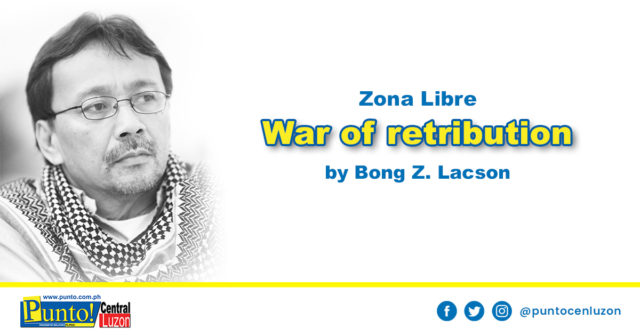TIT FOR TAT. The very words that came out of the President’s mouth last Friday, as he ordered the military to give communist rebels “what they deserve,” squarely laying the blame on them for the spate of killings in Negros Oriental.
A total of 15 persons, including four policemen and a lawyer, were killed in separate shooting incidents in a span of one week – July 18-24 – instantly turning the province into a killing field.
“You are killing everybody there. Everyone that is anti-communist or does not want communism, you kill,” he said, adding that the country has been “infested” with NPA rebels he called “parasites.”
On Sunday, the Communist Party of the Philippines issued a statement denouncing Duterte’s order as a “code for killings and torture” directed at red-tagged civilians.
“The New People’s Army is not shaken by Duterte’s threats,” the CPP said. “The NPA can defend itself with arms.”
Furthering: “But unarmed peasants, lawyers, human rights defenders, church people, civilians can’t…The NPA must fight back for them.”
This should give the nation the creeps. As anyone who has lived the last three years of the ‘80s in Pampanga, particularly in Angeles City, could well attest to the horrors of tit for tat applied in the insurgency wars.
A sense of déjà vu: May 1988, during the halcyon days of the presidency of the now sainted Corazon Cojuangco Aquino.
Fiesta time, killing time
MAYTIME IN Pampanga is a swirl of religious rites and feasts – from the Santacruzan and Flores de Mayo to the fiestas of at least five towns and scores of barangays.
The religious solemnity and the bacchanalian feasts attendant to the merry month in the province were shattered this year by the staccato sounds of machineguns, the deadly bangs of .45s, and the fatal swishes of double bladed knives.
May’s orgiastic killings in Pampanga have so far claimed 25 lives – assorted individuals including a whole family of seven, a couple and their three helpers, three holdup men, a Philippine Air Force captain, a barangay chairman and the city engineer, all in Angeles City alone; an Army captain and two sergeants in a single incident and an airman in Porac; two suspected military informers in Guagua; and a town councilor in Arayat.
That total, however, makes up only the reported cases.
While mediamen here have lost track of the number of casualties this year – placed at 57 in mid-March, it is generally believed that with the latest upsurge in killings, the total of 197 casualties for the whole of 1987 “stands to be approximated or even surpassed by next month.”
Local officials have consistently expressed optimism that “the end of the killings is in sight.” One ranking provincial official has even gone to the extent of integrating in all his pronouncements that “the killings in Pampanga are all isolated cases,” that compared with other areas, the province “is very peaceful.” (“They’re just separate cases,” PRO-7 director Police Brig. Gen. Debold Sinas calls the Negros Oriental killings. That’s one echo reverberating across 31 years.)
To which, local residents, mediamen and even some local officials disagree.
Rep. Carmelo F. Lazatin (1st District- Pampanga) said the resurgence of violence in Angeles has reached alarming proportions as he called on the military and civilian authorities to take positive steps including “pre-emptive actions” to confront the deteriorating peace and order situation. (No, martial law was never invoked then, the Marcosian abuses still all too freshly painful in the nation’s memory.)
One city businessman who requested anonymity lamented the city officials’ coming out with “oblique assessments of the problems instead of frontal solutions.”
One civic leader, in obvious exasperation over the spate of killings said he hoped “the rains of June will cool down May’s heat wave of violence.” (People’s Tonight, May 1988)
Angeles fast turning into ‘killing fields’
…The rains of June have not apparently dampened May’s heat of violence here that littered the cityscape with 25 dead bodies.
The uneasy five-day calm starting at the end of May was shattered by a new torrent of slaying…(a Yakult vendor, ex-PC sergeant, active Army sergeant, CHDF chief, and a policeman)…
…All five casualties bore “the mark of the sparrow” — .45 slugs in the head. (the signature mark of the NPA’s Mariano Garcia Brigade)…
…Five incidents, five blasted heads in nine days…(People’s Tonight, June 14, 1988).
Rightist backlash feared
A “rightist backlash” is feared to have commenced in response to the Sparrowmarked killings that started in May and have remained unstopped.
The last two casualties in June’s spate of killings were deemed to be devoid of the Sparrow hit signature…(one) bore multiple gunshot wounds in the face, neck and body, sprawled in the same spot where the city policeman was gunned down a day earlier; the other bore multiple stab wounds in the neck.
…As this developed, city residents are apprehensive that “excesses in the Left and Right scores could spill over to the plain folk, thereby compounding the already tenterhooks state of peace and order in the city.” (People’s Tonight, June 18, 1988).
The Rightist backlash went on to claim the lives of two urban poor and cause-oriented group leaders, a human rights lawyer, and a doctor – all suspected Left sympathizers.
That war of retribution I set on record in an attempt at literary journalism, Brigada .45, summarized in the blurb:
Hagkis ng kaliwa, Bigwas ng kanan. Low Intensity Confl ict. Mula Fields Avenue, ang pamosong kalsada ng kamunduhan, hanggang Nepo Mart, ang sentro ng kalakal; mula Area, ang palengke ng laman, hanggang sa mismong simbahan, walang piniling larangan ang digmaan sa kalunsuran, nanalasa pa’t nandamay sa mga karatig-bayan. Ito ang Lungsod ng Angeles sa huling tatlong taon ng dekada ‘80. Dito inukit ang maiksi nguni’t madugong kasaysayan ng Brigada Mariano Garcia.
Tit for tat. Pray for Negros Oriental.





